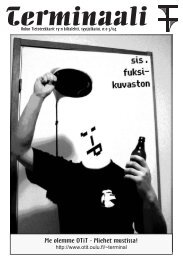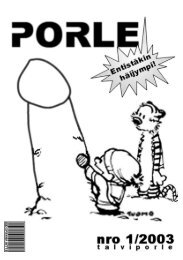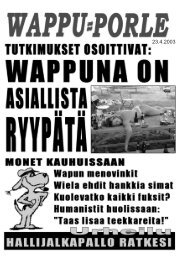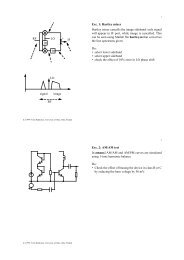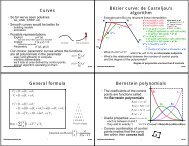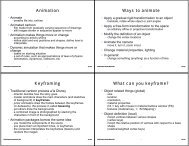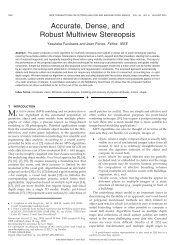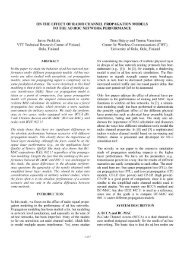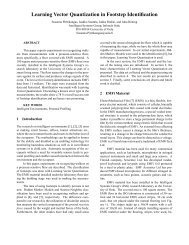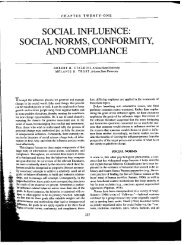Basic Properties and Design Principles of UWB Antennas
Basic Properties and Design Principles of UWB Antennas
Basic Properties and Design Principles of UWB Antennas
Create successful ePaper yourself
Turn your PDF publications into a flip-book with our unique Google optimized e-Paper software.
INVITED<br />
PAPER<br />
<strong>Basic</strong> <strong>Properties</strong> <strong>and</strong> <strong>Design</strong><br />
<strong>Principles</strong> <strong>of</strong> <strong>UWB</strong> <strong>Antennas</strong><br />
Selection <strong>of</strong> suitable antennas from the many existing types, based on<br />
underst<strong>and</strong>ing their characteristics, is essential for effective<br />
ultrawide-b<strong>and</strong> system design.<br />
By Werner Wiesbeck, Fellow IEEE, Grzegorz Adamiuk, Student Member IEEE, <strong>and</strong><br />
Christian Sturm, Student Member IEEE<br />
ABSTRACT | <strong>Basic</strong> principles for ultra-wide-b<strong>and</strong> (<strong>UWB</strong>)<br />
radiation are presented <strong>and</strong> discussed in this paper. The<br />
discussion starts with a description <strong>of</strong> the influence <strong>of</strong> antennas<br />
on <strong>UWB</strong> transmission. The parameters characterizing antennas<br />
in time <strong>and</strong> in frequency domain are specified. Since the<br />
number <strong>of</strong> possible antenna structures is nearly unlimited, the<br />
focus will be on a classification according to different radiation<br />
principles. For each <strong>of</strong> these mechanisms, the typical advantages<br />
<strong>and</strong> disadvantages are discussed, <strong>and</strong> an example<br />
antenna <strong>and</strong> its characteristics are presented. For a wireless<br />
engineer, the problem to solve is the proper design <strong>of</strong> an<br />
antenna with the desired radiation characteristics. The final<br />
outcome <strong>of</strong> this paper is that there exist numbers <strong>of</strong> <strong>UWB</strong><br />
antennas, but not each <strong>of</strong> them is suited for any application,<br />
especially in view <strong>of</strong> radar <strong>and</strong> communication systems<br />
requirements.<br />
KEYWORDS | Ultra-wide-b<strong>and</strong> (<strong>UWB</strong>); <strong>UWB</strong> antenna characterization;<br />
<strong>UWB</strong> link; <strong>UWB</strong> transfer functions<br />
I. <strong>UWB</strong> SIGNAL TRANSFER<br />
CHARACTERIZATION<br />
Typically, narrow-b<strong>and</strong> antennas <strong>and</strong> propagation are<br />
described in the frequency domain. Usually the characteristic<br />
parameters are assumed to be constant over a few<br />
percent b<strong>and</strong>width. For ultra-wide-b<strong>and</strong> (<strong>UWB</strong>) systems,<br />
the frequency-dependent characteristics <strong>of</strong> the antennas<br />
<strong>and</strong> the frequency-dependent behavior <strong>of</strong> the channel have<br />
Manuscript received September 13, 2007; revised March 26, 2008. Current version<br />
published March 18, 2009.<br />
The authors are with the Institut für Hochfrequenztechnik und Elektronik, Universität<br />
Karlsruhe (TH), 76131 Germany (e-mail: werner.wiesbeck@kit.edu).<br />
Digital Object Identifier: 10.1109/JPROC.2008.2008838<br />
to be considered. On the other h<strong>and</strong>, <strong>UWB</strong> systems are<br />
<strong>of</strong>ten realized in an impulse-based technology, <strong>and</strong><br />
therefore the time-domain effects <strong>and</strong> properties have to<br />
be known as well [1]. Hence there is a dem<strong>and</strong> for both a<br />
frequency-domain representation <strong>and</strong> a time-domain<br />
representation <strong>of</strong> the system description. In the following,<br />
these characterizations in the frequency domain <strong>and</strong> in the<br />
time domain are presented. All parameters are uniformly<br />
used in the whole paper but may not be necessarily<br />
compliant with the denotation presented in the cited<br />
literature. The coordinate system throughout this paper is<br />
asshowninFig.1.<br />
A. <strong>UWB</strong> Frequency-Domain Signal Link<br />
Characterization<br />
For the frequency-domain description, it is assumed<br />
that the transmit antenna is excited with a continuouswave<br />
signal with the frequency f. The relevant parameters<br />
for the frequency-domain link description are:<br />
/ amplitude <strong>of</strong> transmit signal UTxðfÞ in [V];<br />
/ amplitude <strong>of</strong> receive signal URxðfÞ in [V];<br />
/ radiated field strength at position rETxðf; r; Tx; TxÞ<br />
in [V/m];<br />
/ transfer function <strong>of</strong> the transmit antenna<br />
HTxðf; Tx; TxÞ in [m];<br />
/ transfer function <strong>of</strong> the receive antenna<br />
HRxðf; Rx; RxÞ in [m];<br />
/ characteristic transmit antenna impedance<br />
ZC;TxðfÞ in [ ];<br />
/ characteristic receive antenna impedance ZC;RxðfÞ<br />
in ½ Š;<br />
/ antenna gain Gðf; ; Þ;<br />
/ distance between Tx-Rx antennas rTxRx in [m].<br />
The antenna transfer functions represent a twodimensional<br />
vector with two orthogonal polarization<br />
372 Proceedings <strong>of</strong> the IEEE |Vol.97,No.2,February2009 0018-9219/$25.00 Ó2009 IEEE<br />
Authorized licensed use limited to: Oulu University. Downloaded on March 30, 2009 at 06:48 from IEEE Xplore. Restrictions apply.
Fig. 1. Coordinate system for <strong>UWB</strong> link <strong>and</strong> antenna characterization.<br />
components HCo <strong>and</strong> HX. The dimension <strong>of</strong> the transfer<br />
functions is meter, <strong>and</strong> they are equivalent to effective<br />
antenna heights, dependent on frequency [2]. The<br />
characteristic antenna impedances define the air interface<br />
reflection coefficients. HTxðf; Tx; TxÞ is the transfer<br />
function that relates the transmit signal UTxðfÞ to the<br />
radiated field strength ETxðf; rÞ for an antenna in the<br />
transmit mode [see (1)]<br />
ETxðf; rÞ<br />
p ¼ ej!rTxRx=c0<br />
HTxðf; Tx; TxÞ j! UTxðfÞ<br />
p ffiffiffiffiffiffiffiffiffi : (1)<br />
ffiffiffiffiffi<br />
Z0<br />
2 rTxRxc0<br />
ZC;Tx<br />
HRxðf; Rx; RxÞ is the transfer function that relates the<br />
received signal amplitude URxðfÞ to the incident field<br />
ERxðf; rÞ (in the frequency domain) for an antenna in<br />
the receive mode [see (2)]. The transfer functions are<br />
reciprocal, HTx ¼ HRx, but the direction <strong>of</strong> the signal<br />
flow with respect to the coordinate system has to be<br />
taken into account. With these parameters, the Tx-Rx<br />
link is given in Fig. 2, including the channel. The small<br />
graphs symbolize the typical influence <strong>of</strong> the link<br />
contributions. The initial chirp <strong>and</strong> its derivative are<br />
sketched.<br />
In the frequency-domain description, the consecutive<br />
subsystem parameters are multiplied. The total analytical<br />
Fig. 2. Frequency-domain system link level characterization.<br />
Wiesbeck et al.: <strong>Basic</strong> <strong>Properties</strong> <strong>and</strong> <strong>Design</strong> <strong>Principles</strong> <strong>of</strong> <strong>UWB</strong> <strong>Antennas</strong><br />
description <strong>of</strong> a free space <strong>UWB</strong> propagation link is<br />
given by (2)<br />
URxðfÞ<br />
p ¼ H T Rxðf; Rx; RxÞ<br />
ffiffiffiffiffiffiffiffiffi<br />
ZC;Rx<br />
e j!rTxRx=c0<br />
2 rTxRxc0<br />
HTxðf; Tx; TxÞ j! UTxðfÞ<br />
p ffiffiffiffiffiffiffiffiffi : (2)<br />
ZC;Tx<br />
Two orthogonal polarizations are included in the Tx <strong>and</strong><br />
Rx transfer functions, as noted above. While in narrowb<strong>and</strong><br />
systems the radiation angles <strong>and</strong> influence only<br />
the polarization, amplitude, <strong>and</strong> the phase <strong>of</strong> the signal,<br />
they influence additionally the entire frequency-dependent<br />
signal characteristics in <strong>UWB</strong> systems.<br />
For<strong>UWB</strong>linksinrichscatteringenvironments,e.g.,<br />
indoor, the influence <strong>of</strong> the channel can be described by a<br />
frequency-dependent polarimetric channel transfer matrix<br />
[3].<br />
B. Time-Domain Signal Link Characterization<br />
For the time-domain description, it is assumed that the<br />
transmit antenna is excited with a impulse. The elements<br />
<strong>of</strong> the <strong>UWB</strong> time domain link characterization are:<br />
/ amplitude <strong>of</strong> transmit signal uTxðtÞ in [V];<br />
/ amplitude <strong>of</strong> receive signal uRxðtÞ in [V];<br />
/ impulse response <strong>of</strong> the transmit antenna<br />
hTxðt; Tx; TxÞ in [m/ns];<br />
/ impulse response <strong>of</strong> the receive antenna<br />
hRxðt; Rx; RxÞ in [m/ns];<br />
/ radiated field strength eTxðt; r; Tx; TxÞ;<br />
/ distance between Tx-Rx antennas rTxRx in [m].<br />
In the time domain, the antenna’s transient response<br />
hðt; ; Þ becomes more adequate for the description <strong>of</strong><br />
impulse systems. The antenna’s transient response is<br />
dependent on time, but also on the angles <strong>of</strong> departure<br />
Tx, Tx, respectively, angles <strong>of</strong> arrival Rx, Rx, <strong>and</strong><br />
polarization [4]. As a consequence, the antennas do not<br />
radiate the same pulse in all directions. This may cause<br />
severe problems in communications <strong>and</strong> radar as well. It is<br />
Vol. 97, No. 2, February 2009 | Proceedings <strong>of</strong> the IEEE 373<br />
Authorized licensed use limited to: Oulu University. Downloaded on March 30, 2009 at 06:48 from IEEE Xplore. Restrictions apply.
Wiesbeck et al.: <strong>Basic</strong> <strong>Properties</strong> <strong>and</strong> <strong>Design</strong> <strong>Principles</strong> <strong>of</strong> <strong>UWB</strong> <strong>Antennas</strong><br />
very important to include in system descriptions the angular<br />
behavior <strong>of</strong> the antennas since all transmitted or received<br />
paths, e.g., in indoor applications, are weighted by the<br />
antenna patterns <strong>and</strong> therefore contribute with different<br />
time domain characteristics, e.g., polarization, amplitude,<br />
phase, <strong>and</strong> delay to the received voltage uRxðtÞ. In Fig. 3, the<br />
time-domain link level scheme is shown. The small graphs<br />
symbolize the typical influence <strong>of</strong> the link contributions. The<br />
initial pulse <strong>and</strong> its derivative are sketched.<br />
Any antenna differentiates any signal, because antennas<br />
do not radiate dc signals. Equations (1) <strong>and</strong> (2) have,<br />
after conversion to the time domain, the form presented in<br />
(3) <strong>and</strong> (4), respectively. Fundamental operations like the<br />
multiplication in the frequency domain are substituted by<br />
convolution in the time domain. Equation (3) relates the<br />
radiated field strength eTxðt; rÞ to the excitation voltage<br />
uTxðtÞ <strong>and</strong> the transient response <strong>of</strong> the transmit antenna<br />
hTxðt; Tx; TxÞ [5]. In (4), again only free-space propagation<br />
is regarded (line <strong>of</strong> sight Tx-Rx)<br />
eTxðt; rÞ<br />
p ¼<br />
ffiffiffiffiffi<br />
Z0<br />
1<br />
2 rTxRxc0<br />
hTxðt; Tx; TxÞ<br />
uRxðtÞ<br />
p ¼ h T Rxðt; Rx; RxÞ<br />
ffiffiffiffiffiffiffiffiffi<br />
ZC;Rx<br />
1<br />
2 rTxRxc0<br />
hTxðt; Tx; TxÞ<br />
t<br />
t<br />
rTxRx<br />
c0<br />
@ uTxðtÞ<br />
p (3)<br />
@t<br />
rTxRx<br />
c0<br />
ffiffiffiffiffiffiffiffiffi<br />
ZC;Tx<br />
@ uTxðtÞ<br />
p : (4)<br />
@t<br />
ffiffiffiffiffiffiffiffiffi<br />
ZC;Tx<br />
The delay time <strong>of</strong> the channel is taken care <strong>of</strong> by the<br />
antenna spacing rTxRx. The transient response functions<br />
are also reciprocal, hTx ¼ hRx, but the direction <strong>of</strong> signal<br />
flow with respect to the coordinate system has to be taken<br />
into account.<br />
The antennas are an essential part <strong>of</strong> any wireless<br />
system, <strong>and</strong> their properties have to be carefully taken into<br />
account during all steps <strong>of</strong> the system design. For <strong>UWB</strong><br />
impulse systems, this is vital.<br />
Fig. 3. <strong>UWB</strong> system link level characterization in time domain.<br />
374 Proceedings <strong>of</strong> the IEEE |Vol.97,No.2,February2009<br />
II. <strong>UWB</strong> DEFINITIONS AND<br />
ANTENNA PARAMETERS<br />
The desired operating frequencies are given by:<br />
/ U.S. FCC regulation [6] as 3.1 to 10.6 GHz;<br />
/ European regulation [7] (2007j131jEC)as6.0to<br />
8.5 GHz;<br />
/ special allocations, e.g., ground penetrating radar<br />
or wall radar;<br />
but not limited to these. A general definition <strong>of</strong> <strong>UWB</strong> is<br />
stated with the relative b<strong>and</strong>width<br />
2ðfH fLÞ=ðfH þ fLÞ > 0:2 (5)<br />
where fH <strong>and</strong> fL aretheupper<strong>and</strong>lowerb<strong>and</strong>limits,<br />
respectively. Relative b<strong>and</strong>widths in excess <strong>of</strong> 100% are<br />
possible for some antenna types.<br />
A. Antenna Characterization Parameters<br />
In contrast to classic narrow-b<strong>and</strong> antenna theory,<br />
where the antenna characteristics are regarded for only a<br />
small b<strong>and</strong>width, the characterization <strong>of</strong> antennas over an<br />
ultrawide frequency range requires new specific quantities<br />
<strong>and</strong> representations [1], [8]. In this section, both timedomain<br />
<strong>and</strong> frequency-domain representations are regarded.<br />
Depending on the application, the relevant ones<br />
have to be selected. In general, the Fourier transforms<br />
forward <strong>and</strong> backward are the operations to switch from<br />
frequency domain to time domain, <strong>and</strong> vice versa.<br />
An impulse fed to an <strong>UWB</strong> antenna is subject to:<br />
/ differentiation;<br />
/ dispersion (energy storage);<br />
/ radiation;<br />
/ losses (dielectric/ohmic).<br />
The antenna’s complete behavior, including frequency<br />
dependency, can be described by the linear system theory.<br />
The characteristics are expressed either by a time-domain<br />
impulse response hðt; Tx; TxÞ or by the frequencydomain<br />
transfer function Hðf; Tx; TxÞ, as given earlier,<br />
both <strong>of</strong> which contain the full information on the antenna<br />
radiation. The dispersion <strong>of</strong> the antenna can be analyzed<br />
by regarding the analytic impulse response, which is<br />
Authorized licensed use limited to: Oulu University. Downloaded on March 30, 2009 at 06:48 from IEEE Xplore. Restrictions apply.
Fig. 4. Characterization <strong>of</strong> the antenna time-domain transient<br />
response (here: horn antenna).<br />
calculated by the Hilbert transform H commonly used in<br />
signal processing.<br />
h þ ðtÞ ¼ðhðtÞþjHfhðtÞgÞ: (6)<br />
The envelope jh þ ðtÞj <strong>of</strong> the analytic impulse response<br />
localizes the distribution <strong>of</strong> energy versus time <strong>and</strong> is<br />
hence a direct measure for the dispersion <strong>of</strong> an antenna.<br />
Typical examples <strong>of</strong> measured antenna impulse<br />
responses hðtÞ <strong>and</strong> jh þ ðtÞj are shown in Fig. 4 for a given<br />
polarization <strong>and</strong> direction ð ; Þ <strong>of</strong> radiation with the<br />
further characteristic parameters for the peak pulse value<br />
pð ; Þ, the width <strong>of</strong> the pulse full-width at half-maximum<br />
(FWHM), <strong>and</strong> the ringing duration r. Note that all<br />
parameters are dependent on polarization <strong>and</strong> spatial<br />
coordinates rð ; Þ.<br />
Examples for specific quantities are given later for the<br />
presented antennas.<br />
1) Peak Value <strong>of</strong> the Envelope: The peak value pð ; Þ <strong>of</strong><br />
the analytic envelope jh þ ðtÞj is a measure for the maximal<br />
value <strong>of</strong> the strongest peak <strong>of</strong> the antenna’s time-domain<br />
transient response envelope. It is mathematically defined as<br />
pð ; Þ¼max h<br />
t<br />
þ j ðt; ; Þj<br />
in m<br />
: (7)<br />
ns<br />
Ahighpeakvaluepð ; Þ is desirable.<br />
2) Envelope Width: The envelope width describes the<br />
broadening <strong>of</strong> the radiated impulse <strong>and</strong> is defined as the<br />
Wiesbeck et al.: <strong>Basic</strong> <strong>Properties</strong> <strong>and</strong> <strong>Design</strong> <strong>Principles</strong> <strong>of</strong> <strong>UWB</strong> <strong>Antennas</strong><br />
width <strong>of</strong> the magnitude <strong>of</strong> the analytic envelope jh þ ðtÞj at<br />
half maximum (FWHM). Analytically, it is defined as<br />
FWHM ¼ t1jjhþðt1Þj¼p=2t2jt1Gt2; hþ j ðt2Þj¼p=2in<br />
ns: (8)<br />
The envelope width should not exceed a few hundred<br />
picoseconds in order to ensure high data rates in<br />
communications or high resolution in radar applications.<br />
3) Ringing: The ringing r <strong>of</strong> a <strong>UWB</strong> antenna is<br />
undesired <strong>and</strong> usually caused by resonances due to energy<br />
storageormultiplereflectionsintheantenna.Itresultsin<br />
oscillations <strong>of</strong> the radiated pulse after the main peak. The<br />
duration <strong>of</strong> the ringing r, whichisdefinedasthetime<br />
until the envelope has fallen from the peak value pð ; Þ<br />
below a certain lower bound pð ; Þ, is measured as<br />
follows:<br />
r¼ ¼ t1j h þ ðt1Þ¼ p t2j t2 G t1^h þ ðt2Þ¼p<br />
in ns: (9)<br />
The duration r <strong>of</strong> the ringing <strong>of</strong> a <strong>UWB</strong> antenna should<br />
be negligibly small, i.e., less than a few envelope widths<br />
FWHM. The energy contained in ringing is <strong>of</strong> no use at all;<br />
it lowers the peak value pð ; Þ. It can therefore be<br />
eliminated by, e.g., absorbing materials.<br />
4) Transient Gain: The transient gain gTð ; Þ is an<br />
integral quality measure that characterizes the ability <strong>of</strong> an<br />
antenna to radiate the power <strong>of</strong> a given waveform uTxðtÞ<br />
gTð ; Þ ¼<br />
where the norm is defined by<br />
duTxðtÞ<br />
dt<br />
hðt; ; Þ<br />
pffiffiffi k c0uTxðtÞk<br />
2<br />
kHð!; ; Þj!UTxðfÞk<br />
¼ 2<br />
pffiffiffi k c0UTxðfÞk<br />
2 (10)<br />
kfðxÞk ¼<br />
Z 1<br />
1<br />
2<br />
jfðxÞjdx: (11)<br />
5) Gain in Frequency Domain: Thegaininfrequency<br />
domain is defined like in narrow-b<strong>and</strong> systems. It can be<br />
calculated from the antenna transfer function<br />
Gðf; ; Þ¼<br />
4 f 2<br />
c 2 0<br />
jHðf; ; Þj<br />
2 : (12)<br />
Vol. 97, No. 2, February 2009 | Proceedings <strong>of</strong> the IEEE 375<br />
Authorized licensed use limited to: Oulu University. Downloaded on March 30, 2009 at 06:48 from IEEE Xplore. Restrictions apply.
Wiesbeck et al.: <strong>Basic</strong> <strong>Properties</strong> <strong>and</strong> <strong>Design</strong> <strong>Principles</strong> <strong>of</strong> <strong>UWB</strong> <strong>Antennas</strong><br />
It is important that the transfer function is multiplied<br />
by f 2 .<br />
6) Group Delay: The group delay gð!Þ <strong>of</strong> an antenna<br />
characterizes the frequency dependence <strong>of</strong> the time delay.<br />
It is defined in frequency domain<br />
gð!Þ ¼ d’ð!Þ<br />
d!<br />
¼ d’ðfÞ<br />
2 df<br />
(13)<br />
where ’ðfÞ is the frequency-dependent phase <strong>of</strong> the<br />
radiated signal.<br />
Of interest is also the mean group delay g, asitisa<br />
single number for the whole <strong>UWB</strong> frequency range<br />
Z<br />
1<br />
g ¼<br />
!2 !1<br />
!2<br />
!1<br />
gð!Þd!: (14)<br />
A nondistorted structure is characterized by a constant<br />
group delay, i.e., linear phase, in a relevant frequency<br />
range. The nonlinearities <strong>of</strong> a group delay indicate the<br />
resonant character <strong>of</strong> the device, which implicates the<br />
ability <strong>of</strong> the structure to store the energy. It results in<br />
ringing <strong>and</strong> oscillations <strong>of</strong> the antenna impulse response<br />
hðtÞ [9]. A measure for the constancy <strong>of</strong> the group delay is<br />
the deviation from the mean group delay g, denoted as<br />
relative group delay g;relð!Þ (15)<br />
g;relð!Þ ¼ gð!Þ g: (15)<br />
Examples <strong>of</strong> the relative group delay <strong>of</strong> the Vivaldi<br />
antenna <strong>and</strong> the logarithmic periodic dipole array (Log-<br />
Per) antenna (see Section III-A <strong>and</strong> D) in the frequency<br />
range from 3 to 11 GHz are shown in Fig. 5. In the case <strong>of</strong><br />
the Vivaldi antenna, which is a nonresonant structure, the<br />
relative group delay shows only weak <strong>and</strong> slow oscillations<br />
over the whole frequency b<strong>and</strong>. On the other side, the<br />
relative group delay <strong>of</strong> the Log-Per antenna shows strong<br />
<strong>and</strong> sharp oscillations over the whole frequency b<strong>and</strong>,<br />
which results in an oscillation <strong>of</strong> the antenna impulse<br />
response hLog PerðtÞ. For this antenna, the group delay is<br />
frequency dependent, <strong>and</strong> lower frequencies show a higher<br />
relative group delay. It is caused by the frequencydependent<br />
phase centers <strong>of</strong> the radiation.<br />
III. <strong>UWB</strong> ANTENNA PRINCIPLES<br />
The radiation <strong>of</strong> guided waves has been discussed<br />
intensively in the past. It is the common underst<strong>and</strong>ing<br />
that the key mechanism for radiation is charge acceleration<br />
[10], [11]. The question to answer for <strong>UWB</strong> is: what kind <strong>of</strong><br />
376 Proceedings <strong>of</strong> the IEEE |Vol.97,No.2,February2009<br />
Fig. 5. Relative group delay g;relðfÞ <strong>of</strong> a Vivaldi antenna<br />
<strong>and</strong> a Log-Per antenna.<br />
structures facilitates the charge acceleration over a very<br />
wide b<strong>and</strong>width? The ultrawide b<strong>and</strong>width radiation is<br />
based on a few principles:<br />
/ traveling-wave structures;<br />
/ frequency-independent antennas (angular constant<br />
structures);<br />
/ self-complementary antennas;<br />
/ multiple resonance antennas;<br />
/ electrically small antennas.<br />
In most cases the radiation starts where the electric<br />
field connects 180 out-<strong>of</strong>-phase currents with half a<br />
wavelength spacing. Many antennas radiate by a combination<br />
<strong>of</strong> two or more <strong>of</strong> the above principles <strong>and</strong> can<br />
therefore not be simply classified.<br />
In the following, the relationships between the radiation<br />
principles <strong>and</strong> the properties <strong>of</strong> the antennas are<br />
discussed. Each explanation <strong>of</strong> the radiation phenomenon<br />
is supported by an example <strong>of</strong> an antenna.<br />
A. Traveling-Wave <strong>Antennas</strong><br />
Traveling-wave antennas <strong>of</strong>fer for the guided wave a<br />
smooth, almost not recognizable transition with the fields<br />
accelerated to free-space propagation speed co. Typical<br />
antennas are tapered wave guide antennas [12]Vfor<br />
example, the horn antenna (see Fig. 4) or the Vivaldi<br />
antenna (see Fig. 6). Other radiating traveling-wave<br />
structures are, e.g., the slotted waveguide or the dielectric<br />
rod antenna. Here the focus will be on the Vivaldi antenna<br />
as an example, for which different feed structures like<br />
microstrip line, slot line, <strong>and</strong> antipodal can be applied.<br />
The Vivaldi antenna guides the wave from the feed in a<br />
slot line to a wide-b<strong>and</strong> taper. The exponential taper is a<br />
priori wide-b<strong>and</strong>, because it <strong>of</strong>fers for all frequencies<br />
within the given b<strong>and</strong>width the proper radiation condition.<br />
Other tapers, like polynomial tapers or any other<br />
Authorized licensed use limited to: Oulu University. Downloaded on March 30, 2009 at 06:48 from IEEE Xplore. Restrictions apply.
Fig. 6. Aperture coupled Vivaldi antenna. (Left) Top view;<br />
(right) bottom view with feed line. Substrate size 75 78 mm 2 .<br />
mathematical function that provides a smooth transition,<br />
can be used <strong>and</strong> optimized, regarding the input reflection<br />
coefficient <strong>and</strong> the radiation characteristics. A typical<br />
structure is shown in Fig. 6, etched on a dielectric<br />
substrate. The Vivaldi is fed at the narrow side <strong>of</strong> the slot.<br />
For <strong>UWB</strong>, the major tasks are the wide-b<strong>and</strong> frequencyindependent<br />
feed <strong>and</strong> slot-line terminations. The feed<br />
shown here is designed with a March<strong>and</strong> balun network<br />
with aperture coupling. Nonresonant aperture coupling is<br />
usually a good choice for <strong>UWB</strong> feed structures. This allows<br />
also for an impedance matching in a wide range. A stub,<br />
<strong>and</strong> the slot line by a circular shaped cavity, terminate the<br />
microstrip feed line. The antenna can be designed<br />
relatively compact. The propagation velocity v on the<br />
structure changes from the slot-line wave velocity vsl to c0<br />
at the end <strong>of</strong> the taper. It varies only slightly with<br />
frequency. The Vivaldi antenna’s time-domain transient<br />
response in the E-plane is shown in Fig. 7. This, for<br />
narrow-b<strong>and</strong> antennas’ unusual representation, displays<br />
the impulse distortion by the antenna in time t versus the<br />
E-plane angle . The Vivaldi antenna has a rather low<br />
Wiesbeck et al.: <strong>Basic</strong> <strong>Properties</strong> <strong>and</strong> <strong>Design</strong> <strong>Principles</strong> <strong>of</strong> <strong>UWB</strong> <strong>Antennas</strong><br />
Fig. 7. Measured impulse response jh þ ðt; Þj <strong>of</strong> the Vivaldi antenna <strong>of</strong> Fig. 6 in E-plane versus frequency.<br />
distortion compared to other <strong>UWB</strong> antennas. The high<br />
peak value ðp ¼ 0:35 m/nsÞ <strong>and</strong> the short duration <strong>of</strong> the<br />
transient response envelope [ð FWHM ¼ 135 psÞ; see<br />
Fig. 4] st<strong>and</strong> for very low dispersion <strong>and</strong> ringing. The<br />
ringing <strong>of</strong> the antenna is due to multiple reflections at the<br />
substrate edges <strong>and</strong> parasitic currents along the outer<br />
substrate edges. The ringing can be reduced by enlarging<br />
the transverse dimensions <strong>of</strong> the antenna, by metal flares<br />
or by chokes. Absorbing materials around the substrate<br />
edges reduce the ringing without influencing the other<br />
characteristics <strong>of</strong> the transient response. The slightly<br />
asymmetric impulse response results from the feed line.<br />
The frequency- <strong>and</strong> angle-dependent gain Gðf; ¼ 90-; Þ<br />
in Fig. 8 is calculated from the measured directional<br />
transfer function Hðf; ¼ 90-; Þ. The gain is quite<br />
constant versus frequency in the main beam direction.<br />
The maximum gain Gmax is 7.9 dBi at 5.0 GHz; at the lower<br />
frequencies, close to 3 GHz, small resonances are visible.<br />
The average gain G in the FCC frequency b<strong>and</strong> is 5.7 dBi.<br />
The main parameters <strong>of</strong> the Vivaldi antenna are summarized<br />
in Table 1.<br />
The Vivaldi antenna is well suited for direct planar<br />
integration <strong>and</strong> also for <strong>UWB</strong> antenna arrays for radar <strong>and</strong><br />
communications. In the past it has been used for special<br />
cases <strong>of</strong> high power radiation.<br />
B. Frequency-Independent <strong>Antennas</strong><br />
Rumsey investigated the fundamentals <strong>of</strong> frequencyindependent<br />
antennas in the 1960s [13]. He observed that<br />
a scaled version <strong>of</strong> a radiating structure must exhibit the<br />
same characteristics like the original one, when fed with a<br />
signal whose wavelength is scaled by the same factor. As a<br />
consequence, if the shape <strong>of</strong> an antenna is invariant to<br />
physical scaling, its radiating behavior is expected to be<br />
independent <strong>of</strong> frequency. The typical realization is an<br />
angular constant structure, which is described only by<br />
Vol. 97, No. 2, February 2009 | Proceedings <strong>of</strong> the IEEE 377<br />
Authorized licensed use limited to: Oulu University. Downloaded on March 30, 2009 at 06:48 from IEEE Xplore. Restrictions apply.
Wiesbeck et al.: <strong>Basic</strong> <strong>Properties</strong> <strong>and</strong> <strong>Design</strong> <strong>Principles</strong> <strong>of</strong> <strong>UWB</strong> <strong>Antennas</strong><br />
Fig. 8. Measured gain Gðf; ¼ 90 ; Þ <strong>of</strong> the Vivaldi antenna <strong>of</strong> Fig. 6 in E-plane versus frequency.<br />
angles. It must be noted that the independence from<br />
frequency does not necessarily refer to the input impedance<br />
<strong>of</strong> the structure. In order to obtain a constant input<br />
impedance, additional principles like those described in<br />
Section III-C have to be applied.<br />
The scaling usually involves constant angles. It is<br />
possibletodefineaBtruncation principle[ to apply this<br />
concept to the practical case, where the size <strong>of</strong> any physical<br />
object is obviously finite [14]. In fact, provided that the<br />
overall current on the antenna tends to decrease due to the<br />
radiation, when moving away from the feeding point, it is<br />
possibletodefinealimitedBactive[ region, where the<br />
current falls below relevant values. If the actual, finite<br />
antenna contains this area, it can be assumed that the<br />
truncation <strong>of</strong> the geometry does not modify the behavior <strong>of</strong><br />
the antenna around the chosen wavelength. A typical<br />
example <strong>of</strong> a frequency-independent antenna is the<br />
biconical antenna [15].<br />
A planar example <strong>of</strong> the biconical antenna is the bowtie<br />
antenna. The antenna structure consists <strong>of</strong> two triangular<br />
metal sheets (see Fig. 9). They are usually fed by a<br />
symmetric line (twin line), which is matched to the feed<br />
Table 1 <strong>UWB</strong> Parameters <strong>of</strong> the Vivaldi Antenna <strong>of</strong> Fig. 6 in<br />
Main Beam Direction<br />
378 Proceedings <strong>of</strong> the IEEE |Vol.97,No.2,February2009<br />
point impedance. In the case <strong>of</strong> an asymmetric feed line<br />
(like coaxial or microstrip lines), a balun transformer is<br />
needed. The bowtie antenna has for the FCC <strong>UWB</strong><br />
frequency b<strong>and</strong> reasonable dimensions. The application <strong>of</strong><br />
aperture feed <strong>and</strong> further optimizations allow very<br />
compact design.<br />
The aperture coupled bowtie antenna consists <strong>of</strong> two<br />
triangular radiating patches, <strong>of</strong> which one serves as a<br />
ground plane for the tapered microstrip feed line that ends<br />
with a broadb<strong>and</strong> stub (see Fig. 9). The feeding structure<br />
couples the energy from an asymmetric microstrip line to<br />
the radiating bowtie elements through the aperture formed<br />
Fig. 9. (Left) Aperture coupled bowtie antenna; bottom view with feed<br />
line. (Right) Top view; symmetric fed bowtie antenna with balun.<br />
Authorized licensed use limited to: Oulu University. Downloaded on March 30, 2009 at 06:48 from IEEE Xplore. Restrictions apply.
Fig. 10. Measured gain Gðf; ¼ 90 ; Þ <strong>of</strong> an aperture coupled bowtie antenna in H-plane versus frequency.<br />
by the tips <strong>of</strong> the triangles. Therefore the antenna is called<br />
aperture coupled bowtie antenna. This feeding technique<br />
is basically similar to the operation <strong>of</strong> the well-known<br />
microstrip slot-line transitions with a March<strong>and</strong> balun.<br />
Almost no additional ringing isintroducedbythiscoupling<br />
mechanism. The pulses on the radiating elements are<br />
traveling faster than those on the line, due to the lower<br />
effective "r;eff. This is compensated by the fact that the stub<br />
length is shorter than the length <strong>of</strong> the radiating elements.<br />
The aperture-coupled bowtie antenna has a nearly<br />
omnidirectional radiation pattern in the H-plane (Fig. 10).<br />
Thereforethistype<strong>of</strong>antennacan find application, e.g., in<br />
communications in mobile devices. It can be realized quite<br />
Fig. 11. Measured impulse response jh þ ðtÞj <strong>of</strong> the<br />
bowtie antenna in H-plane.<br />
Wiesbeck et al.: <strong>Basic</strong> <strong>Properties</strong> <strong>and</strong> <strong>Design</strong> <strong>Principles</strong> <strong>of</strong> <strong>UWB</strong> <strong>Antennas</strong><br />
small. Fig. 11 presents the measured impulse response<br />
jh þ ðtÞj <strong>of</strong> the antenna in Fig. 9. The almost omnidirectional<br />
radiation in H-plane is well visible, accompanied by<br />
a small ringing <strong>of</strong> the antenna.<br />
Other types <strong>of</strong> antennas with frequency-independent<br />
characteristics might be some versions <strong>of</strong> logarithmicperiodic<br />
antennas or spiral antennas [16]. Although these<br />
antennas can show frequency-independent characteristics,<br />
they are based on a different design principle, <strong>and</strong> their<br />
properties are different compared to those described<br />
above. In general, antennas may combine more than one<br />
radiation principle <strong>and</strong> may change the radiation principle<br />
versus frequency.<br />
C. Self-Complementary <strong>Antennas</strong><br />
Self-complementary antennas are characterized by a<br />
self-complementary metallization [17]. This means that<br />
metal can be replaced by dielectric <strong>and</strong> vice versa without<br />
Fig. 12. Truncated fractal antenna to show the principle<br />
<strong>of</strong> self-complementary antennas.<br />
Vol. 97, No. 2, February 2009 | Proceedings <strong>of</strong> the IEEE 379<br />
Authorized licensed use limited to: Oulu University. Downloaded on March 30, 2009 at 06:48 from IEEE Xplore. Restrictions apply.
Wiesbeck et al.: <strong>Basic</strong> <strong>Properties</strong> <strong>and</strong> <strong>Design</strong> <strong>Principles</strong> <strong>of</strong> <strong>UWB</strong> <strong>Antennas</strong><br />
Fig. 13. Self-complementary antennas. (Left) Two-arm logarithmic<br />
spiral antenna <strong>and</strong> (right) sinuous antenna.<br />
changing the antenna’s structure (Fig. 12). The behavior <strong>of</strong><br />
self-complementary structures can be analyzed by applying<br />
Babinet’s principle [18]. This results in an invariant input<br />
impedance <strong>of</strong><br />
Zin ¼ ZF0=2 ¼ 60 (16)<br />
with ZF0 being the free-space impedance. Self-complementary<br />
structures only guarantee a constant input<br />
impedance, but not necessarily constant radiation characteristics<br />
independent from frequency. It is also possible<br />
to design structures that are similar to self-complementary<br />
structures but have an unbalanced ratio <strong>of</strong> metalized to<br />
nonmetalized areas. These structures exhibit an input<br />
impedance that is nearly constant versus frequency but<br />
different from ZF0=2 [19]. For exact description <strong>of</strong> selfcomplementary<br />
antennas, the reader is referred to [20].<br />
Typical c<strong>and</strong>idates are the 90 bowtie antenna, the sinuous<br />
antenna, the logarithmic spiral antenna [21], or some<br />
fractal antennas [22].<br />
An example <strong>of</strong> a two-arm logarithmic spiral antenna is<br />
shown in Fig. 13. This antenna realizes the principle <strong>of</strong><br />
frequency independence; the metallization is only defined<br />
by angles, <strong>and</strong> it follows Babinet’s principle. The two arms<br />
Fig. 14. Current distribution on a logarithmic spiral antenna: (a) f ¼ 300 MHz <strong>and</strong> (b) f ¼ 450 MHz.<br />
380 Proceedings <strong>of</strong> the IEEE |Vol.97,No.2,February2009<br />
<strong>of</strong> the antenna are fed in the center with a symmetric line<br />
with an impedance <strong>of</strong> ZL ¼ 60 . When properly<br />
designed, the logarithmic spiral antenna radiates where<br />
the two arms are spaced by =2, i.e., where the<br />
circumference is =2. By a proper dimensioning <strong>of</strong> the<br />
structure, the antenna can be made broadb<strong>and</strong> up to<br />
several 100% b<strong>and</strong>width.<br />
The principle <strong>of</strong> radiation can be seen by plotting the<br />
current distribution into the antenna <strong>of</strong> Fig. 14. The<br />
diameter <strong>of</strong> the outer arms reaches 40 cm in this case. In<br />
Fig. 14(a), the antenna is excited with the frequency <strong>of</strong><br />
300 MHz <strong>and</strong> in (b) with 450 MHz. It can be noted that at<br />
lower frequencies, where the wavelength is longer, the<br />
high current amplitudes occur at a larger diameter on the<br />
spiral than in the case <strong>of</strong> the higher frequency <strong>of</strong> 450 MHz.<br />
The Bvanishing[ <strong>of</strong> the currents outside <strong>of</strong> the maximum<br />
currents indicates that energy has been radiated.<br />
The logarithmic spiral antenna is a directional antenna<br />
with two main beams orthogonal to the spiral plane. The<br />
radiated wave is circularly polarized, provided the pulse<br />
length covers 360 <strong>of</strong> the radiating circumference. The<br />
polarizations in the two main radiation directions are<br />
orthogonal to each other. One beam is usually suppressed<br />
by absorbing material. It prevents propagation <strong>of</strong> the<br />
orthogonal polarization simultaneously.<br />
The frequency dependence <strong>of</strong> the position <strong>of</strong> the<br />
radiating area <strong>and</strong> therefore frequency-dependent time<br />
delays result in a broadening <strong>and</strong> a smaller peak value <strong>of</strong><br />
the antenna impulse response, compared to, e.g., the<br />
Vivaldi antenna.<br />
As another c<strong>and</strong>idate for the visualization <strong>of</strong> the<br />
characteristics <strong>of</strong> frequency-independent antennas, the<br />
Archimedian spiral antenna is analyzed. This antenna has,<br />
compared to the logarithmic spiral antenna, constant line<br />
width <strong>and</strong> spacing, <strong>and</strong> these are usually identical. Due to<br />
the close separation <strong>of</strong> adjacent lines, they couple strongly.<br />
This causes the radiation where adjacent lines are in phase,<br />
i.e., where the circumference is . To analyze the<br />
transmitted pulse characteristic, in the simulation tool a<br />
Authorized licensed use limited to: Oulu University. Downloaded on March 30, 2009 at 06:48 from IEEE Xplore. Restrictions apply.
Fig. 15. Simulation <strong>of</strong> the received electric field eRxðtÞ from an<br />
Archimedian spiral antenna (xy-plane) with linear polarized<br />
electric field probes in x-, y-, z-direction; input pulse<br />
is a Gauss pulse with FWHM ¼ 88 ps.<br />
linearly polarized electric field probe is set in the far field<br />
<strong>of</strong> the Archimedian spiral antenna. The electric field<br />
probes are arranged along the x-, y-, <strong>and</strong> z-axis, whereas the<br />
antenna is positioned in the xy-plane. The received electric<br />
field eRxðtÞ <strong>of</strong> a simulation <strong>of</strong> this configuration excited<br />
with a FWHM ¼ 88 ps Gauss pulse is shown in Fig. 15.<br />
The radiated <strong>UWB</strong> signal has a strong, short peak with a<br />
reasonable ringing. Since the radiated pulse is circularly<br />
polarized, both exðtÞ <strong>and</strong> eyðtÞ components are present.<br />
The ezðtÞ components are not excited since the radiated<br />
wave is a transverse electromagnetic mode wave. A<br />
problem <strong>of</strong> all spiral antennas for <strong>UWB</strong> operation may<br />
be the rotation <strong>of</strong> the radiated field vector with frequency.<br />
It has to be kept in mind that for a pulsed mode operation,<br />
the pulse duration has to be sufficient in order to cover<br />
360 <strong>of</strong> field vector orientation for circular polarization.<br />
D. Multiple Resonance <strong>Antennas</strong><br />
Multiple resonance antennas are combinations <strong>of</strong><br />
multiple, narrow-b<strong>and</strong>, radiating elements. Each elementVfor<br />
example, a dipoleVcovers a limited b<strong>and</strong>width,<br />
e.g., 20% <strong>of</strong> the total <strong>UWB</strong> b<strong>and</strong>width. Typical c<strong>and</strong>idates<br />
are the Log-Per [23] <strong>and</strong> fractal antennas.<br />
The planar Log-Per antenna (Fig. 16) consists <strong>of</strong> n<br />
adjoining unit cells (dipoles), with the dimensions l <strong>of</strong><br />
adjacent cells scaled by logðl =l þ1Þ ¼constant [24]. Each<br />
dipole is etched with one half on the top layer <strong>and</strong> the<br />
other half on the bottom layer <strong>of</strong> the substrate. The<br />
antenna is fed, for example, by a coaxial line via a triplate<br />
line inside the structure at the high-frequency port. This<br />
structure can be optimized for low return loss<br />
ðS11 G 10 dBÞ in the whole FCC <strong>UWB</strong> frequency b<strong>and</strong>.<br />
The design <strong>of</strong> the antenna is compact (60 50 2mm 3 ),<br />
with 3 dB beamwidths 3 dB 65 in the E-plane <strong>and</strong><br />
Wiesbeck et al.: <strong>Basic</strong> <strong>Properties</strong> <strong>and</strong> <strong>Design</strong> <strong>Principles</strong> <strong>of</strong> <strong>UWB</strong> <strong>Antennas</strong><br />
Fig. 16. Log-Per antenna with a coaxial connector feeding<br />
the inner triplate line.<br />
H in the H-plane. These values are quite constant over the<br />
desired frequency range. As can be seen from Fig. 17, the<br />
impulse response <strong>of</strong> the Log-Per antenna exhibits strong<br />
oscillations. This can be explained by the consecutively<br />
excited ringing <strong>of</strong> coupled, resonating dipoles.<br />
For reasons <strong>of</strong> comparison with other antennas, Fig. 17<br />
shows the transient response hðt; Þ, ¼ 0 versus the<br />
E-plane angle <strong>and</strong> time t. The broadening <strong>of</strong> the impulse<br />
response compared to the Vivaldi antenna is obvious.<br />
Consequently, the peak value p <strong>of</strong> the antenna impulse<br />
response reduces to only 0.13 m/ns. It is due to the resonant<br />
structure <strong>of</strong> the radiating dipoles. Any <strong>UWB</strong> antenna with<br />
resonant elements broadens the radiated impulse, i.e.,<br />
increases the FWHM <strong>and</strong> lowers the peak value p.<br />
Fig. 18 is a cut in the main beam <strong>of</strong> the transient<br />
response hðt; Þ, ¼ 0. The resonant character <strong>of</strong> the Log-<br />
Per antenna is even more obvious in this representation,<br />
Fig. 17. Measured impulse response jh þ ðt; Þj, ¼ 0<br />
<strong>of</strong> the Log-Per antenna (Fig. 16) in the E-plane.<br />
Vol. 97, No. 2, February 2009 | Proceedings <strong>of</strong> the IEEE 381<br />
Authorized licensed use limited to: Oulu University. Downloaded on March 30, 2009 at 06:48 from IEEE Xplore. Restrictions apply.
Wiesbeck et al.: <strong>Basic</strong> <strong>Properties</strong> <strong>and</strong> <strong>Design</strong> <strong>Principles</strong> <strong>of</strong> <strong>UWB</strong> <strong>Antennas</strong><br />
Fig. 18. Simulated impulse response <strong>of</strong> the Log-Per antenna<br />
(Fig. 16) in the main beam direction.<br />
where the characteristics are determined to FWHM ¼<br />
805 ps <strong>and</strong> r¼0:22 ¼ 605 ps.<br />
In Fig. 19, the gain Hðf; Þ <strong>of</strong> the Log-Per antenna is<br />
shown. The antenna exhibits a relatively constant <strong>and</strong><br />
stable radiation pattern over the frequency range. The<br />
collapse <strong>of</strong> the transfer function in main beam direction at<br />
particular frequencies <strong>and</strong> simultaneous side radiation at<br />
the same frequencies can be noticed. This is due to the<br />
excitation <strong>of</strong> higher order modes, e.g., -resonances, <strong>of</strong> the<br />
B =2-dipoles.[<br />
Fig. 19. Measured transfer function jHðf; Þj <strong>of</strong> the Log-Per antenna<br />
versus frequency in the E-plane.<br />
382 Proceedings <strong>of</strong> the IEEE |Vol.97,No.2,February2009<br />
Table 2 <strong>UWB</strong> Parameters <strong>of</strong> the Log-Per Antenna <strong>of</strong> Fig. 17 in<br />
Main Beam Direction<br />
The main parameters <strong>of</strong> the Log-Per antenna <strong>of</strong> Fig. 16<br />
are shown in Table 2.<br />
E. Electrically Small <strong>Antennas</strong><br />
Electrically small antennas [25] are for any desired <strong>UWB</strong><br />
operation Bequally bad[ concerning impedance matching<br />
<strong>and</strong> radiation. These antennas are far below resonance<br />
a G 0=5 (17)<br />
which is specifying the antenna dimensions, a being the size<br />
<strong>of</strong> the radiating element (not the ground plane). Thus<br />
similar conditions for all frequencies exist. With a proper<br />
impedance transformation, the antennas can be made<br />
<strong>UWB</strong>. Typical c<strong>and</strong>idates are the different types <strong>of</strong> D-dot<br />
probe antennas, small monopole antennas [26], <strong>and</strong> the<br />
Hertzian dipole.<br />
In Fig. 20, a typical rotational symmetric <strong>UWB</strong> monocone<br />
antenna with a height <strong>of</strong> 20 mm ( =5 at 3 GHz) is<br />
shown. The monocone antenna, as an asymmetric structure,<br />
does not require any balun for an asymmetric feed<br />
line; however, it needs (in theory) an infinite ground<br />
plane, which is cut for practical applications. For the<br />
regarded b<strong>and</strong>width, monocone antennas with a ground<br />
plane diameter larger than 40 mm (see Fig. 22) exhibit a<br />
return loss below S11 G 10 dB. For smaller ground<br />
planes, the matching becomes difficult for a 50 reference<br />
impedance. The finite ground plane also affects<br />
the stability <strong>of</strong> the radiation pattern versus frequency <strong>and</strong><br />
the impulse radiating properties. Just recently, an antenna<br />
has been proposed that overcomes this problem by<br />
Fig. 20. Monocone antenna with enlarged ground plane,<br />
with d ¼ 80 mm diameter.<br />
Authorized licensed use limited to: Oulu University. Downloaded on March 30, 2009 at 06:48 from IEEE Xplore. Restrictions apply.
Fig. 21. Planar monopole antennas. (Left) CPW fed; (right) microstrip<br />
line fed with ground plane on the bottom side [28], [29].<br />
compensating the dominating antenna capacity <strong>of</strong> electrically<br />
small antennas by inductive coupling to sectorial<br />
loops [27].<br />
The monocone properties can be well approximated by<br />
the planar structures like planar monopoles (Fig. 21).<br />
These are very well suited for short-range communications,<br />
as they can easily be integrated with different planar<br />
lines <strong>and</strong> circuits.<br />
The monocone antenna has an omnidirectional radiation<br />
pattern in H-plane. The impulse response hðtÞ <strong>and</strong><br />
gain GðfÞ for a monocone antenna with reduced ground<br />
plane ðd ¼ 40 mmÞ are shown in the E-plane in Figs. 22<br />
<strong>and</strong> 23, respectively. It can be seen that the impulse<br />
response is short, which indicates small ringing, <strong>and</strong> the<br />
antenna radiates over a wide elevation angle from<br />
10 G G 90 with a relatively constant gain GðfÞ. At<br />
higher frequencies the radiation is more upwards <strong>and</strong> a<br />
second beam emerges from the ground plane. Because <strong>of</strong><br />
Fig. 22. Monocone antenna <strong>and</strong> its measured impulse response jh þ ðtÞj<br />
in the E-plane (ground plane diameter d ¼ 40 mm).<br />
Wiesbeck et al.: <strong>Basic</strong> <strong>Properties</strong> <strong>and</strong> <strong>Design</strong> <strong>Principles</strong> <strong>of</strong> <strong>UWB</strong> <strong>Antennas</strong><br />
Fig. 23. Measured gain Gðf; Þ <strong>of</strong> monocone antenna versus<br />
frequency in the E-plane.<br />
the omnidirectional character <strong>of</strong> the antenna, the small<br />
FWHM ¼ 75 ps value <strong>of</strong> the antenna impulse response,<br />
<strong>and</strong> the nearly frequency-independent gain, the monocone<br />
antenna is <strong>of</strong>ten applied for channel measurements.<br />
In narrow-b<strong>and</strong> operations, it is assumed that the<br />
antenna radiates identical signals in all directions <strong>of</strong> the<br />
antenna characteristic Cð ; Þ. In ultra-wide-b<strong>and</strong>, this<br />
cannot be taken for granted, as will be shown for the<br />
monocone antenna. Fig. 24 shows the impulse response <strong>of</strong><br />
the monocone antenna for ¼ const. versus the elevation<br />
angle . It can clearly be seen that the radiated signals are<br />
elevation angle dependent.<br />
Fig. 24. Measured impulse response hðt; ; ¼ 90 Þ as a function <strong>of</strong><br />
elevation for the monocone antenna.<br />
Vol. 97, No. 2, February 2009 | Proceedings <strong>of</strong> the IEEE 383<br />
Authorized licensed use limited to: Oulu University. Downloaded on March 30, 2009 at 06:48 from IEEE Xplore. Restrictions apply.
Wiesbeck et al.: <strong>Basic</strong> <strong>Properties</strong> <strong>and</strong> <strong>Design</strong> <strong>Principles</strong> <strong>of</strong> <strong>UWB</strong> <strong>Antennas</strong><br />
In a multipath environment, these signals overlap at<br />
the receiver, which may cause severe distortion. Proper<br />
channel models can be used to study these effects [30].<br />
IV. <strong>UWB</strong> ANTENNA SYSTEM ASPECTS<br />
In practice from a system point <strong>of</strong> view, two cases for <strong>UWB</strong><br />
have to be distinguished:<br />
/ multiple narrow b<strong>and</strong>s, e.g., OFDM (ECMA-368<br />
St<strong>and</strong>ard);<br />
/ pulsed operation (IEEE 802.15.4a).<br />
The first case can usually be treated like the well-known<br />
narrow-b<strong>and</strong> operations. The relevant criteria are well<br />
covered by the frequency-dependent transfer function<br />
Hðf; ; Þ. <strong>Antennas</strong> for these applications can be all<br />
earlier discussed types, especially also the Log-Per antenna.<br />
The second case needs a closer look. If in a pulsed<br />
operation for radar or communications the full FCC<br />
b<strong>and</strong>width from 3.1 to 10.6 GHz, i.e., 7.5 GHz, is<br />
coveredVfor example, with the derivative <strong>of</strong> the Gaussian<br />
pulse with FWHM ¼ 88 psVthen the transient behavior,<br />
the impulse response hðt; ; Þ <strong>of</strong> the antenna, has to be<br />
taken into account. In this case, the impulse distortion in<br />
thetimedomain<strong>and</strong>inthespatialdomainhavetobe<br />
examined for compatibility. An adverse behavior <strong>of</strong> the<br />
impulse response hðt; ; Þ, with the following problems:<br />
/ low peak magnitude pð ; Þ;<br />
/ very wide pulse width FWHM;<br />
/ long ringing r<br />
has influence on the system characteristics, for example, on:<br />
/ the received signal strength uRxðtÞ, ðS=NÞ;<br />
/ the data rate in communications;<br />
/ theresolutioninradar.<br />
These adverse effects set requirements for the antennas<br />
but also for the other <strong>UWB</strong> hardware front-end elements<br />
like amplifiers, filters, equalizers, detectors, <strong>and</strong> so on.<br />
These requirements restrict the potential antennas to<br />
small antennas or traveling wave antennas. C<strong>and</strong>idates are:<br />
/ monocone antenna;<br />
/ bowtie antenna;<br />
REFERENCES<br />
[1] A. Shlivinski, E. Heyman, <strong>and</strong> R. Kastner,<br />
BAntenna characterization in the time<br />
domain,[ IEEE Trans. <strong>Antennas</strong> Propag.,<br />
vol. 45, pp. 1140–1149, Jul. 1997.<br />
[2] A. A. Smith, BReceived voltage versus antenna<br />
height,[ IEEE Trans. Electromagn. Compat.,<br />
vol. EMC-11, pp. 104–111, Aug. 1969.<br />
[3] W. Sörgel, S. Schulteis, S. Knörzer, <strong>and</strong><br />
W. Wiesbeck, BDeconvolution <strong>of</strong> the antennas<br />
from directional <strong>UWB</strong> channel<br />
measurements,[ in Proc. Joint 9th Int. Conf.<br />
Electromagn. Adv. Applicat. (ICEAA)/ 11th Eur.<br />
Electromagn. Struct. Conf. (EESC), Torino,<br />
Italy, Sep. 2005, pp. 589–593.<br />
[4] W. Sörgel <strong>and</strong> W. Wiesbeck, BInfluence <strong>of</strong><br />
the antennas on the ultra wideb<strong>and</strong><br />
transmission,[ EURASIP J. Appl. Signal Process.<br />
(Special Issue on <strong>UWB</strong>VState <strong>of</strong> the Art),<br />
pp. 296–305, Mar. 2005.<br />
/ Vivaldi antenna;<br />
/ horn antenna.<br />
All antennas with resonances or spurious surface<br />
currents are bad c<strong>and</strong>idates <strong>and</strong> should be disregarded<br />
for time-domain operation. Among them is definitely the<br />
Log-Per antenna.<br />
For certain cases where circular polarization is<br />
required, further restrictions hold. A logarithmic spiral<br />
antenna, e.g., can only radiate circular polarization if the<br />
pulsedurationislongerthantheequivalentcircumference<br />
<strong>of</strong> the active radiating zone. For 88 ps pulses, this<br />
equivalent circumference should be less than 2.6 cm,<br />
which may contradict the radiation requirement.<br />
These statements make clear that for <strong>UWB</strong> in extension<br />
to research at the component level, also research on the<br />
system level has to be performed.<br />
V. CONCLUSION<br />
[5] E. Farr <strong>and</strong> C. Baum, Time domain<br />
characterization <strong>of</strong> antennas with TEM feeds,<br />
Sensor <strong>and</strong> Simulation note 426, Oct. 1998.<br />
[6] FCC, Revision <strong>of</strong> Part 15 <strong>of</strong> the commission’s<br />
rules regarding ultra wideb<strong>and</strong> transmission<br />
systems, ET Docket 98-153, FCC 02-48,<br />
Feb. 14, 2002.<br />
[7] Commission <strong>of</strong> the European<br />
Communities, BCommission decision<br />
on allowing the use <strong>of</strong> the radio spectrum<br />
for equipment using ultra-wideb<strong>and</strong><br />
technology in a harmonised manner in<br />
the Community,[ Official J. Eur. Union,<br />
Feb. 21, 2007.<br />
[8] H. G. Schantz, BA brief history <strong>of</strong> <strong>UWB</strong><br />
antennas,[ IEEE Aerosp. Electron. Syst. Mag.,<br />
vol. 19, pp. 22–26, Apr. 2004.<br />
[9] D.-H. Kwon, BEffect <strong>of</strong> antenna gain <strong>and</strong><br />
group delay variations on pulse-preserving<br />
capabilities <strong>of</strong> ultrawideb<strong>and</strong> antennas,[<br />
384 Proceedings <strong>of</strong> the IEEE |Vol.97,No.2,February2009<br />
Fig. 25. Comparison <strong>of</strong> characteristic parameters <strong>of</strong> the presented<br />
<strong>UWB</strong> antennas.<br />
Ultra-wide-b<strong>and</strong> as an emerging technology requires for<br />
the antenna characterization a thorough knowledge <strong>of</strong> the<br />
behavior in time domain, in frequency domain, <strong>and</strong>, in<br />
certain cases, in the spatial domain. It has been shown that<br />
for ultra-wide-b<strong>and</strong>, certain antenna classes can be defined<br />
according to their radiating characteristics. In Fig. 25,<br />
typical, relevant data <strong>of</strong> the discussed <strong>UWB</strong> antennas are<br />
compared. h<br />
Authorized licensed use limited to: Oulu University. Downloaded on March 30, 2009 at 06:48 from IEEE Xplore. Restrictions apply.<br />
IEEE Trans. <strong>Antennas</strong> Propag., vol. 54,<br />
pp. 2208–2215, Aug. 2006.<br />
[10] R. P. Meys, BA summary <strong>of</strong> the transmitting<br />
<strong>and</strong> receiving properties <strong>of</strong> antennas,[ IEEE<br />
<strong>Antennas</strong> Propag. Mag., vol. 42, pp. 49–53,<br />
Jun. 2000.<br />
[11] E. K. Miller <strong>and</strong> F. J. Deadrick, BVisualizing<br />
near-field energy flow <strong>and</strong> radiation,[ IEEE<br />
<strong>Antennas</strong> Propag. Mag., vol. 42, pp. 46–54,<br />
Dec. 2000.<br />
[12] D. Schaubert, E. Kollberg, T. Korzeniowski,<br />
T. Thungren, J. Johansson, <strong>and</strong> K. Yngvesson,<br />
BEndfire tapered slot antennas on dielectric<br />
substrates,[ IEEE Trans. <strong>Antennas</strong> Propag.,<br />
vol. AP-33, pp. 1392–1400, Dec. 1985.<br />
[13] V. H. Rumsey, Frequency-Independent<br />
<strong>Antennas</strong>. New York: Academic, 1966.<br />
[14] P. E. Mayes, BFrequency-independent<br />
antennas <strong>and</strong> broad-b<strong>and</strong> derivatives there<strong>of</strong>,[<br />
Proc. IEEE, vol. 80, pp. 103–112, Jan. 1992.
[15] C. A. Balanis, Antenna Theory: Analysis <strong>and</strong><br />
<strong>Design</strong>, 2nd ed. New York: Wiley, 1997,<br />
pp. 542–544.<br />
[16] E. Gschwendtner <strong>and</strong> W. Wiesbeck,<br />
BUltra-broadb<strong>and</strong> car antennas for<br />
communications <strong>and</strong> navigation<br />
applications,[ IEEE Trans. <strong>Antennas</strong> Propag.,<br />
vol. 51, pp. 2020–2027, Aug. 2003.<br />
[17] Y. Mushiake, BSelf-complementary<br />
antennas,[ IEEE <strong>Antennas</strong> Propag. Mag.,<br />
vol. 34, pp. 23–29, Dec. 1992.<br />
[18] H. G. Booker, BSlot aerials <strong>and</strong> their<br />
relation to complementary wire aerials<br />
(Babinet’s principle),[ J. Inst. Elect. Eng.,<br />
pp. 620–627, 1946.<br />
[19] B. H. Burdine, BThe spiral antenna,[<br />
Massachusetts Inst. <strong>of</strong> Technol., Research<br />
Lab. Tech. Rep., Apr. 1955.<br />
[20] G. Deschamps, BImpedance properties<br />
<strong>of</strong> complementary multiterminal planar<br />
structures,[ IEEE Trans. <strong>Antennas</strong> Propag.,<br />
vol. AP-7, pp. 371–378, Dec. 1959.<br />
ABOUT THE AUTHORS<br />
Werner Wiesbeck (Fellow, IEEE) received the<br />
Dipl.-Ing. (M.S.E.E.) <strong>and</strong> Dr.-Ing. (Ph.D.E.E.) degrees<br />
from the Technical University Munich, Germany, in<br />
1969 <strong>and</strong> 1972, respectively.<br />
From 1972 to 1983, he was with AEG-Telefunken<br />
in various positions, including that <strong>of</strong> Head <strong>of</strong><br />
R&D <strong>of</strong> the Microwave Division in Flensburg <strong>and</strong><br />
Marketing Director Receiver <strong>and</strong> Direction Finder<br />
Division, Ulm. During this period, he had product<br />
responsibility for millimeter-wave radars, receivers,<br />
direction finders, <strong>and</strong> electronic warfare systems. From 1983 to<br />
2007, he was Director <strong>of</strong> the Institut für Hochfrequenztechnik und<br />
Elektronik, University <strong>of</strong> Karlsruhe (TH), where he had been Dean <strong>of</strong> the<br />
Faculty <strong>of</strong> Electrical Engineering <strong>and</strong> is now Distinguished Scientist with<br />
the Karlsruhe Institute <strong>of</strong> Technology. Research topics include electromagnetics,<br />
antennas, wave propagation, communications, radar, <strong>and</strong><br />
remote sensing. In 1989 <strong>and</strong> 1994, respectively, he spent a six-month<br />
sabbatical with the Jet Propulsion Laboratory, Pasadena, CA. He is a<br />
member <strong>of</strong> an Advisory Committee <strong>of</strong> the EU-Joint Research Centre<br />
(Ispra/Italy). He is an advisor to the German Research Council (DFG), to<br />
the Federal German Ministry for Research (BMBF), <strong>and</strong> to industry in<br />
Germany.<br />
Dr. Wiesbeck is an Honorary Life Member <strong>of</strong> IEEE GRS-S, a member <strong>of</strong><br />
the Heidelberger Academy <strong>of</strong> Sciences, <strong>and</strong> a member <strong>of</strong> acatech<br />
(German Academy <strong>of</strong> Engineering <strong>and</strong> Technology). He is a member <strong>of</strong><br />
the IEEE GRS-S AdCom (1992–2000), Chairman <strong>of</strong> the GRS-S Awards<br />
Committee (1994–1998, 2002-), Executive Vice President IEEE GRS-S<br />
(1998–1999), President <strong>of</strong> IEEE GRS-S (2000–2001), Associate Editor<br />
IEEE-AP Transactions (1996–1999), <strong>and</strong> past Treasurer <strong>of</strong> the IEEE<br />
German Section (1987–1996, 2003–2007). He has been General Chairman<br />
<strong>of</strong> the 1988 Heinrich Hertz Centennial Symposium, the 1993 Conference<br />
on Microwaves <strong>and</strong> Optics (MIOP ’93), the Technical Chairman <strong>of</strong><br />
International mm-Wave <strong>and</strong> Infrared Conference 2004, Chairman <strong>of</strong> the<br />
German Microwave Conference GeMIC 2006, <strong>and</strong> a member <strong>of</strong> the<br />
scientific committees <strong>and</strong> Technical Program Committees <strong>of</strong> many<br />
conferences. He has received many awards, most recently the IEEE<br />
Millennium Award, the IEEE GRS Distinguished Achievement Award, the<br />
Honorary Doctorate (Dr. h.c.) from the University Budapest/Hungary, the<br />
Honorary Doctorate (Dr.-Ing. E.h.) from the University Duisburg/<br />
Germany, <strong>and</strong> the IEEE Electromagnetics Award 2008.<br />
Wiesbeck et al.: <strong>Basic</strong> <strong>Properties</strong> <strong>and</strong> <strong>Design</strong> <strong>Principles</strong> <strong>of</strong> <strong>UWB</strong> <strong>Antennas</strong><br />
[21] J. Dyson, BThe equiangular spiral antenna,[<br />
IEEE Trans. <strong>Antennas</strong> Propag., vol. AP-7,<br />
pp. 181–187, Apr. 1959.<br />
[22] D. H. Werner, R. L. Haupt, <strong>and</strong> P. L. Werner,<br />
BFractal antenna engineering: The theory <strong>and</strong><br />
design <strong>of</strong> fractal antenna arrays,[ IEEE<br />
<strong>Antennas</strong> Propag. Mag., vol. 41, pp. 37–58,<br />
Oct. 1999.<br />
[23] R. Pantoja, A. Sapienza, <strong>and</strong> F. M. Filho, BA<br />
microwave printed planar log-periodic dipole<br />
array antenna,[ IEEE Trans. <strong>Antennas</strong> Propag.,<br />
vol. AP-35, pp. 1176–1178, Oct. 1987.<br />
[24] C. Peixeiro, B<strong>Design</strong> <strong>of</strong> log-periodic dipole<br />
antennas,[ Proc. Inst. Elect. Eng. Microw.,<br />
<strong>Antennas</strong> Propag., vol. 135, no. 2, pt. H,<br />
pp. 98–102, Apr. 1988.<br />
[25] T. Yang, S.-Y. Suh, R. Nealy, W. A. Davis, <strong>and</strong><br />
W. L. Stutzman, BCompact antennas for <strong>UWB</strong><br />
applications,[ IEEE Aerosp. Electron. Syst. Mag.,<br />
vol. 19, pp. 16–20, May 2004.<br />
[26] C. Harrison, Jr. <strong>and</strong> C. Williams, Jr.,<br />
BTransients in wide-angle conical antennas,[<br />
IEEE Trans. <strong>Antennas</strong> Propag., vol. AP-13,<br />
pp. 236–246, Mar. 1965.<br />
[27] N. Behdad <strong>and</strong> K. Sarab<strong>and</strong>i, BA compact<br />
antenna for ultrawide-b<strong>and</strong> applications,[<br />
IEEE Trans. <strong>Antennas</strong> Propag., vol. 53,<br />
pp. 2185–2192, Jul. 2005.<br />
[28] C.-C Lin, Y.-C. Kan, L.-C. Kuo, <strong>and</strong><br />
H.-R. Chuang, BA planar triangular monopole<br />
antenna for <strong>UWB</strong> communication,[ IEEE<br />
Microw. Compon. Lett., vol. 15, pp. 624–626,<br />
Oct. 2005.<br />
[29] X. Chen, J. Liang, P. Li, L. Guo,<br />
C. C. Chiau, <strong>and</strong> C. G. Parini, BPlanar<br />
<strong>UWB</strong> monopole antennas,[ in Proc. Microw.<br />
Conf. (APMC 2005), Dec. 4–7, 2005, vol. 1.<br />
[30] A. F. Molisch, J. R. Foerster, <strong>and</strong><br />
M. Pendergrass, BChannel models for<br />
ultrawide-b<strong>and</strong> personal area networks,[<br />
EEE Wireless Commun., vol. 10, pp. 14–21,<br />
Dec. 2003.<br />
Grzegorz Adamiuk (Student Member, IEEE)<br />
received the Dipl.-Ing. degree in electrical engineering<br />
from Technical University <strong>of</strong> Gdansk,<br />
Pol<strong>and</strong>, <strong>and</strong> the Universität Karlsruhe (TH),<br />
Germany, in 2006. He is currently pursuing the<br />
Ph.D.E.E. degree at the Universität Karlsruhe.<br />
Since 2006, he has been with the Institut für<br />
Hochfrequenztechnik und Elektronik, Universität<br />
Karlsruhe, as a Research Associate. His main<br />
research topic is <strong>UWB</strong> technology with focus on<br />
<strong>UWB</strong> antennas <strong>and</strong> channel characterization.<br />
Christian Sturm (Student Member, IEEE) received<br />
the Dipl.-Ing. degree in electrical engineering<br />
<strong>and</strong> information technologies from Universität<br />
Karlsruhe (TH), Germany, in 2005.<br />
Since February 2005, he has been with the<br />
Institut für Hochfrequenztechnik und Elektronik,<br />
Universität Karlsruhe, as a Research Associate. His<br />
main research areas are multiple antenna transmission<br />
systems <strong>and</strong> the propagation <strong>of</strong> ultrawide-b<strong>and</strong><br />
signals in indoor scenarios. He has<br />
experience in signal processing <strong>and</strong> antenna array processing techniques.<br />
He is a Lecturer for the Carl-Cranz-Series for Scientific Education<br />
<strong>and</strong> for the European School <strong>of</strong> <strong>Antennas</strong>.<br />
Vol. 97, No. 2, February 2009 | Proceedings <strong>of</strong> the IEEE 385<br />
Authorized licensed use limited to: Oulu University. Downloaded on March 30, 2009 at 06:48 from IEEE Xplore. Restrictions apply.




